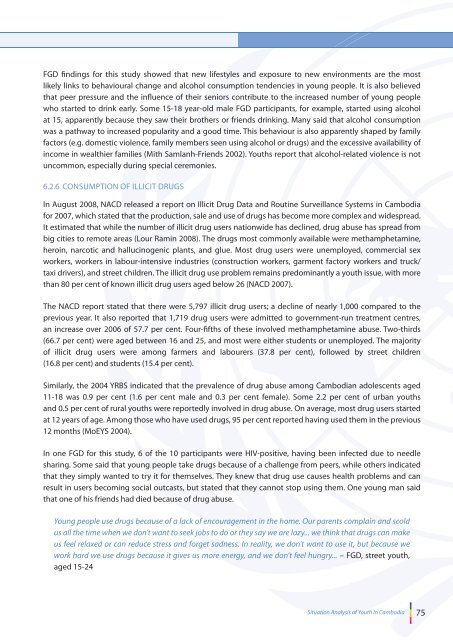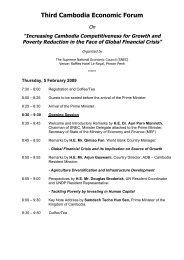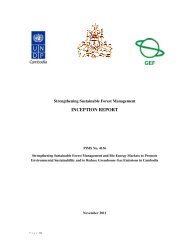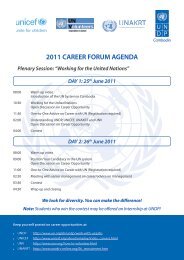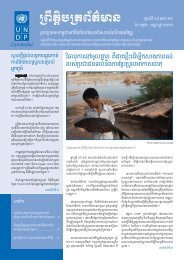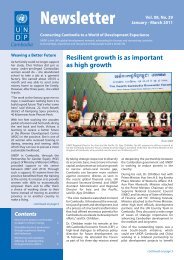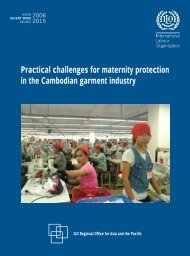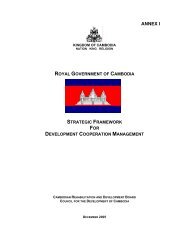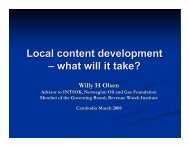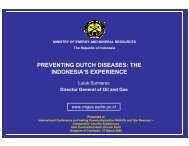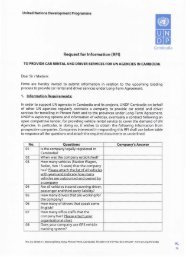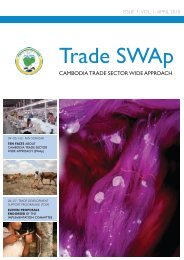UN Analysis Final.pdf - United Nations in Cambodia
UN Analysis Final.pdf - United Nations in Cambodia
UN Analysis Final.pdf - United Nations in Cambodia
You also want an ePaper? Increase the reach of your titles
YUMPU automatically turns print PDFs into web optimized ePapers that Google loves.
FGD f<strong>in</strong>d<strong>in</strong>gs for this study showed that new lifestyles and exposure to new environments are the most<br />
likely l<strong>in</strong>ks to behavioural change and alcohol consumption tendencies <strong>in</strong> young people. It is also believed<br />
that peer pressure and the <strong>in</strong>fluence of their seniors contribute to the <strong>in</strong>creased number of young people<br />
who started to dr<strong>in</strong>k early. Some 15-18 year-old male FGD participants, for example, started us<strong>in</strong>g alcohol<br />
at 15, apparently because they saw their brothers or friends dr<strong>in</strong>k<strong>in</strong>g. Many said that alcohol consumption<br />
was a pathway to <strong>in</strong>creased popularity and a good time. This behaviour is also apparently shaped by family<br />
factors (e.g. domestic violence, family members seen us<strong>in</strong>g alcohol or drugs) and the excessive availability of<br />
<strong>in</strong>come <strong>in</strong> wealthier families (Mith Samlanh-Friends 2002). Youths report that alcohol-related violence is not<br />
uncommon, especially dur<strong>in</strong>g special ceremonies.<br />
6.2.6 CONSUMPTION OF ILLICIT DRUGS<br />
In August 2008, NACD released a report on Illicit Drug Data and Rout<strong>in</strong>e Surveillance Systems <strong>in</strong> <strong>Cambodia</strong><br />
for 2007, which stated that the production, sale and use of drugs has become more complex and widespread.<br />
It estimated that while the number of illicit drug users nationwide has decl<strong>in</strong>ed, drug abuse has spread from<br />
big cities to remote areas (Lour Ram<strong>in</strong> 2008). The drugs most commonly available were methamphetam<strong>in</strong>e,<br />
hero<strong>in</strong>, narcotic and halluc<strong>in</strong>ogenic plants, and glue. Most drug users were unemployed, commercial sex<br />
workers, workers <strong>in</strong> labour-<strong>in</strong>tensive <strong>in</strong>dustries (construction workers, garment factory workers and truck/<br />
taxi drivers), and street children. The illicit drug use problem rema<strong>in</strong>s predom<strong>in</strong>antly a youth issue, with more<br />
than 80 per cent of known illicit drug users aged below 26 (NACD 2007).<br />
The NACD report stated that there were 5,797 illicit drug users; a decl<strong>in</strong>e of nearly 1,000 compared to the<br />
previous year. It also reported that 1,719 drug users were admitted to government-run treatment centres,<br />
an <strong>in</strong>crease over 2006 of 57.7 per cent. Four-fifths of these <strong>in</strong>volved methamphetam<strong>in</strong>e abuse. Two-thirds<br />
(66.7 per cent) were aged between 16 and 25, and most were either students or unemployed. The majority<br />
of illicit drug users were among farmers and labourers (37.8 per cent), followed by street children<br />
(16.8 per cent) and students (15.4 per cent).<br />
Similarly, the 2004 YRBS <strong>in</strong>dicated that the prevalence of drug abuse among <strong>Cambodia</strong>n adolescents aged<br />
11-18 was 0.9 per cent (1.6 per cent male and 0.3 per cent female). Some 2.2 per cent of urban youths<br />
and 0.5 per cent of rural youths were reportedly <strong>in</strong>volved <strong>in</strong> drug abuse. On average, most drug users started<br />
at 12 years of age. Among those who have used drugs, 95 per cent reported hav<strong>in</strong>g used them <strong>in</strong> the previous<br />
12 months (MoEYS 2004).<br />
In one FGD for this study, 6 of the 10 participants were HIV-positive, hav<strong>in</strong>g been <strong>in</strong>fected due to needle<br />
shar<strong>in</strong>g. Some said that young people take drugs because of a challenge from peers, while others <strong>in</strong>dicated<br />
that they simply wanted to try it for themselves. They knew that drug use causes health problems and can<br />
result <strong>in</strong> users becom<strong>in</strong>g social outcasts, but stated that they cannot stop us<strong>in</strong>g them. One young man said<br />
that one of his friends had died because of drug abuse.<br />
Young people use drugs because of a lack of encouragement <strong>in</strong> the home. Our parents compla<strong>in</strong> and scold<br />
us all the time when we don’t want to seek jobs to do or they say we are lazy... we th<strong>in</strong>k that drugs can make<br />
us feel relaxed or can reduce stress and forget sadness. In reality, we don’t want to use it, but because we<br />
work hard we use drugs because it gives us more energy, and we don’t feel hungry... – FGD, street youth,<br />
aged 15-24<br />
Situation <strong>Analysis</strong> of Youth <strong>in</strong> <strong>Cambodia</strong><br />
75


